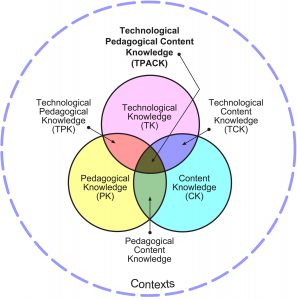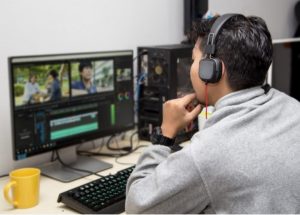Generation Z and Challenges for Teachers
Majority of students at present were born in mid-to-late 1990s and early 2010s. It’s about 1997 up to 2012. This generation is called as generation Z that colloquially as zoomers. To make it easy, they are also called as Gen Z. They have more special characteristic compared to previous generations. People say that they cannot live without technology. Gen Z seem like always connected to virtual life through social media and internet. Besides, they can solve various problems using technology such as computation system as well.
Considering that the students nowadays are Gen Z that always connect to technology, hence, it is important for teachers to be able to design appropriate learning activities for them. Of course, the learning design must integrate appropriate technology to make them attracted and learning become more effective.
The challenge of integrating technology in learning process is higher day by day. It is not only a formality. It is not enough if teachers only use presentation software to show the material and explain it directly while the students are only listening to it passively. The technology must be a part of tools that will make students be easier to learn.
There are so many technology that can be chosen by teachers. However, the teachers must be sure to choose technology which is appropriate with learning material and activity. Besides, it is important to make sure that the technology is integrated well in the learning design to attract students. It means that teachers should use such universal framework that technology should be involved in all process of learning. Especially in designing activities which consists of knowledge building, comprehending concept, and learning outcome. Teachers should use a suitable framework. Well, TPACK framework is a framework which can be used by teachers in facing this challenge.

Definition and the History of TPACK
TPACK stands for Technological Pedagogical Content Knowledge. TPACK is a theory which is developed to explain about a set of knowledge needed by teachers to teach effectively using technology. This theory gives a new framework to integrate technology into education in order to provide the best learning experience for students.
TPACK model is firstly written by Punya Mishra dan Mattew J. Koehler in 2006 in a scientific writing entitled “Technological Pedagogical Content Knowledge: A Framework for Teacher Knowledge”. This theory was finally appeared after 5 years research which focused on how learning was operated in various class levels. This research was conducted based on Lee S. Shulman who wrote “Those Who Understand: Knowledge Growth in Teaching” in 1986. At the beginning, Shulman discussed about knowledge concept which must be owned by teachers in teaching. It consisted content knowledge (knowledge about subject material which will be taught) and pedagogical knowledge (knowledge about how to teach or method to deliver material). Then this theory is called as Pedagogical Content Knowledge (PCK).
After 20 years, Mishra and Kohler found there was a big change happened in education. It is demand of integrating technology into teaching and learning process. At that time technology was considered as something separated with pedagogy and content. However, by the demand of technology integration, they gradually aware that technological knowledge is equal as a part of PCK.
By their study, Mishra and Kohler found a new framework which is more suitable with present condition. This framework is called as TPACK framework. TPACK adds technological knowledge into PCK which was only consisted of pedagogical knowledge and content knowledge. Hence, TPACK has three areas of knowledge to be mastered by teachers, they are technology, pedagogy, and content. Here is the diagram to show TPACK framework scope.

The diagram above shows that TPACK is a result of collaboration of technological knowledge, pedagogical knowledge, and content. T stands for Technological means how teacher use technology as teaching aid and facilitate pedagogy approach. For instance, the usage of internet, software, etc. PA which stands for pedagogical means how teachers manage the class in conducting teaching and learning process. Teachers should use effective and creative method to reach meaningful learning. While C stands for Content which means particular subject material to be taught such as math, language, science, etc. Content knowledge scope is also about the formulation of material to be comprehend easily by the students.
In more detail scope, the diagram above also shows specific knowledge which are involved within TPACK framework. It consists of 6 areas, they are:
- Technological Knowledge (TK): knowledge about the way to operate computer and appropriate software for teaching and learning process.
- Pedagogical Knowledge (PK): ability to manage learning process for students.
- Content Knowledge (CK): specific subject material such as science, math, etc.
- Technological Content Knowledge (TCK): knowledge about the way of content can be studied and represented by technology. For example computer is used for learning about earth movement.
- Pedagogical Content Knowledge (PCK): the way to formulate content delivery using effective method so that be easy to be understood. It is same as Shulman’s study.
- Technological Pedagogical Knowledge (TPK): it is about how technology can facilitate pedagogical approach. For example using asynchronous discussion in learning.
TPACK emphasized teachers’ framework which include all of those areas. The goal is to have an affective teaching and learning process. TPACK involves connection, interaction, and teachers’ work boundary within those areas of knowledge. When the teachers master TPACK, therefore, it will be realized professional teachers with IT-based who are ready to educate generation Z based on their era.
How to implement TPACK in Teaching and Learning Process
In implementing TPACK to learning process, Judith B. Harris and Mark J. Hofer work with several colleagues from some universities in US to make various activity types. In a scientific article entitled “Grounded’ Technology Integration: Instructional Planning Using Curriculum-Based Activity Type Taxonomies” is explained how TPACK implemented in designing teaching and learning process, they are:
- Implementing content knowledge: determining learning outcome which will be reached by students based on the material learnt.
- Implementing pedagogical knowledge: determining activity types or the way students will learn the material.
- Implementing technological knowledge: determining technology to support teaching and learning process and be able to make students be easier in learning.
Harris and Hofer provide activity types option for some subjects such as math, science, social studies, English, world language, music, physical education, and visual art. Each subject has different taxonomy. For example, taxonomy of math consists of consider, practice, interpret, produce, apply, evaluate, and create. Taxonomy for social studies consists of knowledge building and knowledge expression. While taxonomy for English Education consists of reading process, writing process, language-focused, oral speaking/performance, and listening/watching.
The difference of activity types taxonomy for each subject is caused by the learning design is made using content-based by Harris and Hoffer. Beside the activity types taxonomy, they also recommend the list of technology which may support learning activity by content-based. Here is the example for social studies subject.

There were 44 learning types in teaching and learning of social studies which were identified. The result showed that 17 out of 44 focused to help students to build knowledge, process, and content of social studies material. While another 27 gave students opportunity to express their understanding by using various ways. Six out of 27 activities of expressing knowledge emphasized convergent learning while another 21 are divergent.
As mentioned above, activity types taxonomy for social studies consists of knowledge building dan knowledge expression. For each stage will be given 2 examples of activity types. We can choose one of them and then combine it with another activity types in the next stage.
Knowledge Building Activity Types
To make students totally involved actively in learning the key concept of social studies, they must build or activate their background knowledge in various areas. Here are the example to meet this objective.
|
Activity Types |
Description |
Technology |
| Reading text | Students extract information from printed or digital textbook, historical documents, census data, etc. | Digital archives, websites, electronic books, audiobook |
| Participating in inquiry activity | Students do inquiry activity by using printed or digital data which are provided online. | CIA World Facebook, census data, Excel, Inspire Data |
Knowledge Expression Activity Types
Teachers can determine the aspects or concepts that have been learned by students by analyzing their understanding toward the material given. It can be done as convergent or divergent. Knowledge expression using convergent technique can be implemented by making sure every student has similar understanding toward a material. Here are the examples of activity types in convergent way.
Example of Convergent Knowledge Expression Activity Types
|
Activity Types |
Description |
Technology |
| Creating timeline | Students sequence a set of an event in printed or digital timeline format through webpage or multimedia presentation. | Timeline maker software, presentation software, concept mapping software, word processor |
| Completing review | Students participate to complete review of a material by using paper-based questions and answers in format of game-show using multimedia presentation tools. | Student Response System (SRS), interactive whiteboard for game review (for example: Jeopardy), survey tools |
Some teachers are more interested to see students’ understanding by giving students opportunity to convey their unique argument about particular topic. By using it, basically, students practice to develop their creative thinking skill and dare to deliver their opinion using various ways determined by the teachers. This technique of expressing knowledge is called as divergent. The activity types stages of divergent consists of written activity types, visual activity types, conceptual activity types, product oriented, and participatory. Here are several examples of each activity type.

Example of Divergent Knowledge Expression Activity Types
|
Activity Types |
Description |
Technology |
|
Written Activity Types |
||
| Composing a narrative | By using primary document and secondary information resource students develop their own past story in form of narrative | Word processor, Wiki or another collaborative word processor (to collect writings or contribution from all authors) |
| Creating diary | Students write their own perspective toward an event in the past in form of paper and pencil or digital | Blog, word processor |
|
Visual Activity Types |
||
| Creating illustrative map | Students use symbols or certain pictures to sign various feature in a map that they create | Map outline which is provided online, Google Earth, presentation software, scanner |
| Drawing cartoon | Students draw cartoon or caricature using paper and pencil or digital format | Comic maker software, drawing software, scanner |
|
Conceptual Activity Types |
||
| Developing knowledge websites | Students organize and manage information in websites | Concept making software, presentation software, scanner |
| Developing questions | Students develop questions based on the material discussed | Word processor, Wiki |
|
Product-Oriented Activity Types |
||
| Design an exhibition | Students collect prominent points of a topic and then show it in a physic or virtual exhibition | Wiki, presentation software, video editor software |
| Producing a movie | Students produce a movie by combining some pictures, motion video, music, and narration contains prominent information about a topic | Video editor software, digital camera |
|
Participatory Activity Types |
||
| Roleplay | Students involve in roleplay activity to have experience and internalize a concept or event live or in a video recording | Video editor software, digital camera or camera recorder |
| Engage in civic action | Students write suggestion to government about civic issues or engage in another civic actions | Blog, email, conference video, Think Quest |
That’s all the examples of activity types taxonomy in social studies. More references of activity types in other subjects can be accessed in this link https://activitytypes.wm.edu/index.html.
Conclusion
TPACK is a framework in designing teaching and learning process which appropriate with students nowadays who are generation Z. It emphasizes an effective learning design by using technology as the tools to support material delivery to make it easy to be understood. Judith B. Harris and Mark J. Hofer work collaboratively with colleagues from several institutions to provide references of learning design using TPACK through activity types taxonomy for some subjects. Of course, teachers can adapt and develop the activity types based on the students’ condition and environment. By implementing TPACK teachers are hoped to be competent teachers for generation Z who are able to design effective and attractive learning by integrating technology.


